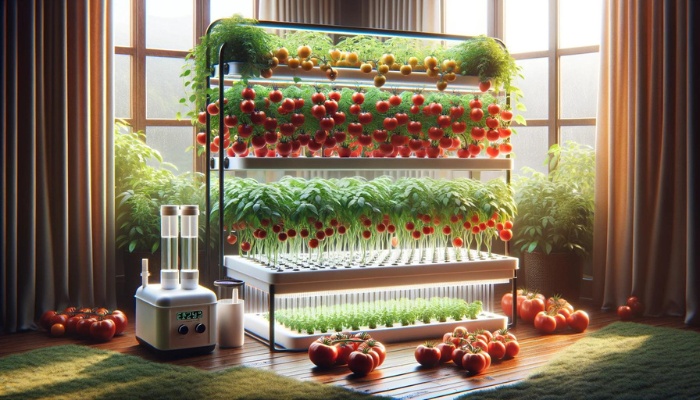Imagine standing in your kitchen, slicing into a plump, juicy tomato that you’ve grown yourself, its vibrant red flesh a testament to the power of hydroponic systems.
You’re probably wondering how you can replicate this success and which system will best suit your needs.
From the simplicity of Deep Water Culture to the efficiency of Drip Irrigation, each option has its unique benefits. Yet, choosing the right system can feel overwhelming.
We’ll unravel the complexity of hydroponic systems for growing tomatoes, helping you make an informed decision that could elevate your gardening game to the next level.
Understanding Hydroponics Basics
Hydroponics, a method where plants grow in a water-based, nutrient-rich solution without soil, fundamentally transforms your approach to cultivating tomatoes.
your success hinges on precision in lighting requirements and pH management.
Tomatoes demand ample light, mimicking the full spectrum of the sun, for photosynthesis and fruitful growth.
You’ll need to invest in high-quality LED grow lights, ensuring they’re positioned strategically to distribute light evenly across your plants. The goal is to replicate natural sunlight conditions, optimizing your tomatoes’ growth phase and maximizing yield.
Equally important is pH management. The ideal pH range for hydroponic tomatoes is between 5.5 and 6.5.
This narrow window ensures nutrients are readily available for absorption by the roots. You’ll need to regularly monitor and adjust the pH levels of your nutrient solution, using pH up or down solutions.
Precision in maintaining this balance is critical; even slight deviations can lead to nutrient lockout, hindering your tomatoes’ development.
Deep Water Culture Systems
Let’s now turn our focus to Deep Water Culture (DWC) systems, a popular hydroponic method for growing tomatoes that offers simplicity and efficiency.
In a DWC setup, your tomato plants are suspended above a nutrient-rich solution, allowing their roots to dangle directly into the water.
This direct immersion in the nutrient solution ensures that the plants have constant access to the food they need to grow. However, managing oxygen levels and lighting requirements is critical in a DWC system.
- Oxygen Levels: Without sufficient oxygen, your plants’ roots could suffocate, leading to poor growth or even death. An air pump and air stone are commonly used to keep the water oxygenated.
- Lighting Requirements: Adequate lighting is vital for photosynthesis. Ensure your DWC system is positioned where your tomato plants receive ample light, whether artificial or natural.
- Nutrient Solution: The nutrient solution must be meticulously balanced. Regular monitoring and adjustments ensure that your tomatoes receive the right amount of nutrients.
- Temperature Control: Keeping the water at an optimal temperature encourages healthy root development and nutrient uptake.
Ebb and Flow Setup
The Ebb and Flow setup is a versatile hydroponic method that periodically floods your tomato plants’ roots with a nutrient solution before draining it away.
This technique is pivotal for precise pH management and optimizing lighting requirements, which are critical for your tomatoes’ growth.
- pH management: Essential for nutrient absorption
- Lighting: Influences photosynthesis and growth
- Flood duration: Affects root oxygenation and nutrient uptake
- Drain efficiency: Prevents overwatering and nutrient buildup
- System scalability: Allow for expansion as your hydroponic garden grows.
In Ebb and Flow systems, you’ll need to keep a keen eye on the pH levels, ensuring they remain within the optimal range for tomato cultivation. This involves regular testing and adjustments to the nutrient solution.
Lighting requirements also play a crucial role; your setup should provide sufficient light for the photosynthesis process without overheating or stressing the plants.
Analyzing these aspects will guide you toward achieving a bountiful tomato harvest in a hydroponic environment.
Nutrient Film Technique
The Nutrient Film Technique (NFT) continuously flows a thin film of nutrient solution over the roots of your tomato plants, optimizing nutrient absorption and oxygen access without the need for a growing medium.
This approach leverages a carefully engineered system to ensure your tomatoes thrive in an optimized environment.
Here’s what you need to know about NFT:
- Channel Slope: The slope of the channels is crucial in NFT systems. It must be just steep enough to allow the nutrient solution to flow gently over the roots, ensuring every plant receives its share of nutrients and oxygen.
- Oxygen Supply: A constant flow of nutrient solution ensures an ample supply of oxygen to the roots, which is vital for healthy plant growth.
- No Growing Medium Required: This technique eliminates the need for a traditional growing medium, reducing the risk of diseases and pests.
- Efficient Nutrient Delivery: The thin film of nutrient solution maximizes contact with the roots, ensuring efficient nutrient uptake.
Drip Irrigation
Drip Irrigation is a system that allows for precise water and nutrient delivery directly to the root zone of your tomato plants.
This method is renowned for its efficiency and effectiveness, especially in optimizing water usage and ensuring that your plants receive exactly what they need when they need it.
A water source is fundamental in a drip irrigation system. Since the system’s drippers can be prone to clogging from sediments and impurities, you’ll need a reliable, clean source of water.
Therefore, filtering your water source becomes essential to maintaining the system’s integrity and performance.
System maintenance is another critical aspect. Regular checks are necessary to ensure that each dripper operates correctly and that there are no leaks or blockages in the lines.
It’s also vital to monitor the nutrient solution’s pH and electrical conductivity (EC) levels to maintain optimal growth conditions.

